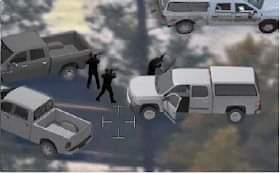FBI told state police not to wear body cameras for 2016 stop of refuge occupation leaders
Prosecutors say witness testimony, audio and video evidence, plus bullet trajectory analysis yielded one conclusion: FBI agent W. Joseph Astarita lied about firing two shots at the truck of refuge occupation spokesman Robert "LaVoy" Finicum in 2016 after he swerved into a snowbank.

Prosecutors say witness testimony, audio and video evidence, plus bullet trajectory analysis yielded one conclusion: FBI agent W. Joseph Astarita lied about firing two shots at the truck of refuge occupation spokesman Robert "LaVoy" Finicum in 2016 after he swerved into a snowbank.
The information is detailed in a 32-page government response to Astarita's motion to dismiss the federal indictment against him. He's pleaded not guilty to three counts of making false statements and two counts of obstruction of justice. Astarita's lawyer claimed the indictment was based on "junk science.''
The government response also reveals that Oregon State Police SWAT troopers at the scene, ordinarily required to wear body cameras, didn't that day at the request of the FBI. The FBI did obtain video from FBI surveillance planes flying above the scene.
State police detectives also normally record interviews of officers who might be involved in a shooting, but they didn't that night when questioning the FBI Hostage Rescue Team members, again at the FBI's request. A follow-up interview with the hostage team members also came with unusual conditions, prosecutors note.
Astarita fired after Finicum's truck swerved into a snowbank at a roadblock and then stepped out of his pickup, investigators said. Astarita's first rifle shot missed Finicum's truck entirely and the second entered Finicum's truck from the roof, "sending sparks into the cabin and blowing out the left rear passenger window next to Ryan Bundy,'' according to federal prosecutors. Finicum wasn't struck.
On cellphone video taken by passenger Shawna Cox, Ryan Bundy, crouched in the back seat, could be heard saying, "I got hit, too,'' according to the government filing.
The shooting came as the FBI and state police moved to arrest the leaders of the armed occupation of the Malheur National Wildlife Refuge as they drove to a meeting in John Day on Jan. 26, 2016.
The bullet that entered the top of the truck came from the right side, slightly to the rear of the truck, and its path could have come only from Astarita or his immediate supervisor, according to Deschutes County Sheriff's Office detectives, who investigated the shooting. The supervisor, identified as B.M., was eliminated as the source, but the government response doesn't say how.
Finicum, 54, was shot and killed by state police a short time later at the scene after he walked away from the truck and reached into his jacket pocket, where he had a loaded pistol, investigators said. The Malheur County district attorney later ruled that the fatal shooting was justified.Another FBI supervisor, identified by the initials "I.M.,'' responded to the scene to find out if any of the hostage team agents had fired their weapons.
I.M. asked Astarita if he had fired his rifle. Astarita's response was "markedly different'' than the other team members but he "clearly communicated'' that he hadn't fired his rifle, prosecutors wrote.Astarita apparently responded with an angry retort, questioning I.M's authority to ask, and another hostage team member told Astarita that he needed to respond, the court filing says. Astarita's lawyer has argued that his client's remark was unresponsive and can't be construed as a false statement.
Three other members of the FBI hostage rescue team who were at the roadblock on U.S. 395 also said they hadn't taken any shots, according to prosecutors.
As a result, "evidence that would otherwise have been gathered and preserved was not,'' Astarita's weapon wasn't seized, examined or secured and an FBI shooting investigation wasn't initiated, prosecutors wrote.Astarita's second response to B.M., his immediate FBI supervisor, was "direct and unequivocal'' that he had not fired his rifle, prosecutors noted.
The FBI ceded the shooting investigation to local authorities, thinking none of the federal agents present had fired their weapons.
Astarita told state police investigators that he was among the agents at the roadblock and described how Finicum's truck approached at about 70 mph. Astarita said he believed Finicum had struck another hostage team agent as he swerved into the snowbank.
"He expressed concern for that operator's safety,'' according to prosecutors. Astarita said he moved into position to help the fallen agent but was unsure of his exact position because he was moving, according to the government's document.
Since Finicum's truck was still running and the engine was revving, Astarita told investigators that it was difficult to hear what was going on but heard other gunshots and saw Finicum fall after Finicum had moved away from the truck.
"At no point in the interview did defendant disclose that he had fired, nor did he mention that evidence, such as shell casings, had been removed from the scene,'' prosecutors wrote.
A major incident team of local authorities processed the shooting scene and Finicum's truck. They found no spent rifle casings in the roadway, though witnesses reported seeing them there.
Using a metal detector, investigators did find two spent casings buried in the snow that were matched to a state police SWAT trooper's rifle.
Deschutes County investigators shared their concerns about missing evidence and unaccounted-for shots with FBI officials in the days after the shooting. I.M., the FBI supervisor who had first questioned Astarita, also expressed frustration to another FBI leader about Astarita's odd response to his routine question. More FBI supervisory agents spoke with Astarita.
On Feb. 6, 2016, two state police detectives reinterviewed Astarita, but by then the hostage rescue team agents knew there were unaccounted-for gunshots and missing shell casings. The agents set conditions for the interview: They could only be interviewed as a group, the interview couldn't be recorded and their lawyer could be present on a speakerphone.The state police detectives found those conditions "particularly an unrecorded group interview - odd and problematic, but reluctantly agreed to them, believing that the alternative would be no interview at all,'' prosecutors wrote.B.M., the leader of Astarita's team, served as the "spokesman'' for the group and did most of the talking. The hostage rescue team agents conveyed individually and through their spokesman that they didn't fire any shots.
Published: Feb. 02, 2018, by Maxine Bernstein | The Oregonian/OregonLive
https://www.oregonlive.com/oregon-standoff/2018/02/fbi_told_oregon_state_police_n.html?

There is no bulge to indicate a pistol was in LaVoy's inner pocket.
☆ A Ponder Gander by Vincent Easley II ▪︎ Real Liberty Media: comparing history to the events of today for an expectation of the future, for our world and mankind as a whole.
Under Section 107 of the Copyright Act 1976, allowance is made for “fair use” for purposes such as criticism, comment, news reporting, teaching, scholarship, and research. ☆
Full Article Copied by Vincent Easley II with great appreciation to Maxine Bernstein for the Journalist she became during the subsequent trial from Portland to Las Vegas.
On a side-note: On February 8, 2018 at the end of the Bundy et al. Trial's dismissal on the way down in an elevator full of mainstream reporters I told her, she gets The Best in MSM for the job she did.
All those big name press reporters were, well let's just say, flabbergasted.
There is a longer story to the change she underwent.
Let me, just say credit goes to Kellie Stewart for calling her out (in a not so subtle manner) and Jason Patrick for explaining to her how she was just writing the same crap as all the other MSM reporters.
She changed, and to that I say bravo 👏
☆

